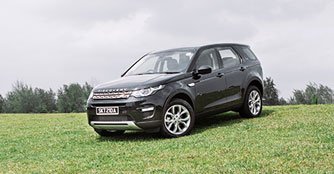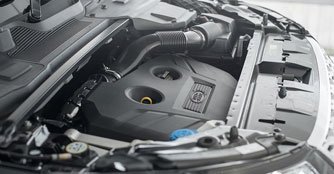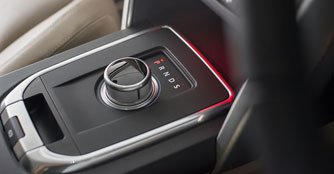Land Rover Discovery Sport 2.0 HSE (A) Review
03 Aug 2015|32,791 views
With the curtain call of Land Rover's introductory vehicle to the compact Sports Utility Vehicle (SUV) market segment, the Freelander, comes the British car manufacturer's all new and highly-anticipated Discovery Sport.
At a length of 4,590mm, the Discovery Sport offers seven seats in the dimensions of a five-seat SUV - something you won't find in the Audi Q5 or the BMW X3.
We had the privilege to get up close and personal with the Discovery Sport a couple of weeks ago at the ZF Global Press Event in Potsdam, Germany, where it was used as a test car to demonstrate the efficiency of the ZF nine-speed automatic transmission. Sure, the Discovery Sport was pretty decent around the track but how will Land Rover's new brainchild fare on our roads?
Exterior
Style may not be the first order of business when it comes to SUVs, but it plays a huge role in the decision making process. Replacing the Freelander with the Discovery Sport, Land Rover seems to be looking at a younger, and slightly less grizzled demographic with its bold and progressive architecture.
The anterior of the Discovery Sport is a composition of strong and dynamic lines, featuring the signature clamshell bonnet on top of a contradistinct two-bar, hexagonal meshed grille.
At a length of 4,590mm, the Discovery Sport offers seven seats in the dimensions of a five-seat SUV - something you won't find in the Audi Q5 or the BMW X3.
We had the privilege to get up close and personal with the Discovery Sport a couple of weeks ago at the ZF Global Press Event in Potsdam, Germany, where it was used as a test car to demonstrate the efficiency of the ZF nine-speed automatic transmission. Sure, the Discovery Sport was pretty decent around the track but how will Land Rover's new brainchild fare on our roads?
Exterior
Style may not be the first order of business when it comes to SUVs, but it plays a huge role in the decision making process. Replacing the Freelander with the Discovery Sport, Land Rover seems to be looking at a younger, and slightly less grizzled demographic with its bold and progressive architecture.
The anterior of the Discovery Sport is a composition of strong and dynamic lines, featuring the signature clamshell bonnet on top of a contradistinct two-bar, hexagonal meshed grille.
 |
Illuminating the road is a pair of Xenon head lights with LED signature, a combination that creates an aggressive stance and commanding road presence.
One may recognise this front end design of the Discovery Sport from that of the Range Rover Evoque and although the new car is built alongside the Evoque at Land Rover's Halewood plant, it is almost entirely redesigned from the B-pillars back, giving the car a longer wheelbase to allow for more rear seat capacity. The car also sensibly ditches the Evoque's aggressively tapered roofline to cater for more headroom and visibility.
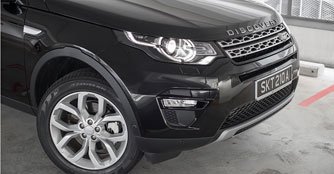
The decision to adopt the semblance of the Evoque whilst offering the practicality of an urban off-roader that is able to haul five adults and two children makes the Discovery Sport a class act - one perfectly capable of balancing style and space in a way that not many can.
 |
Interior
Step inside the cabin and you will find that the Discovery Sport subscribes to Land Rover's belief that interior designs should be kept clean, simple and functional. In the driver's seat, both leg and headroom are aplenty and you get a clear elevated view of the road ahead thanks to Land Rover's raised Sports Command Driving Position.
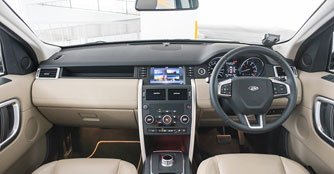
 Although more modest than the Evoque, materials still feel robust and there is a charming, user-friendly candor
Although more modest than the Evoque, materials still feel robust and there is a charming, user-friendly candor
Despite being similar in look and feel to the old infotainment system, the updated version in the Disco Sport is better in almost every way, especially in terms of speed and ease of user-friendliness.
The HSE trim we drove had full leather interior, a panoramic glass roof, sat-nav, keyless entry, optional heated rear seats and a rear view camera. Passengers won't have to worry about their phones' battery life, as the car comes equipped with four USB charging ports to ensure that everything stays charged on the go.
Step inside the cabin and you will find that the Discovery Sport subscribes to Land Rover's belief that interior designs should be kept clean, simple and functional. In the driver's seat, both leg and headroom are aplenty and you get a clear elevated view of the road ahead thanks to Land Rover's raised Sports Command Driving Position.

Despite being similar in look and feel to the old infotainment system, the updated version in the Disco Sport is better in almost every way, especially in terms of speed and ease of user-friendliness.
The HSE trim we drove had full leather interior, a panoramic glass roof, sat-nav, keyless entry, optional heated rear seats and a rear view camera. Passengers won't have to worry about their phones' battery life, as the car comes equipped with four USB charging ports to ensure that everything stays charged on the go.
With an extended wheelbase and some dexterous British engineering, Land Rover has managed to squeeze an optional third row seat into the Discovery Sport. Unique to its segment, Land Rover terms this as a 5+2 seating configuration.
As with all seven-seater SUVs, the optional third row folds out of the boot floor and is intended more for occasional usage because getting to them challenges you to squeeze through a small gap. While it's spacious enough for children, it may cause some discomfort for adults. However, when not necessary, keeping the third row folded flat ups the boot capacity to 981 litres.
Space is more generous in the second row. The seats have the ability to adjust the angle of the backrests, as well as a sliding function to increase or decrease legroom.
As with all seven-seater SUVs, the optional third row folds out of the boot floor and is intended more for occasional usage because getting to them challenges you to squeeze through a small gap. While it's spacious enough for children, it may cause some discomfort for adults. However, when not necessary, keeping the third row folded flat ups the boot capacity to 981 litres.
Space is more generous in the second row. The seats have the ability to adjust the angle of the backrests, as well as a sliding function to increase or decrease legroom.
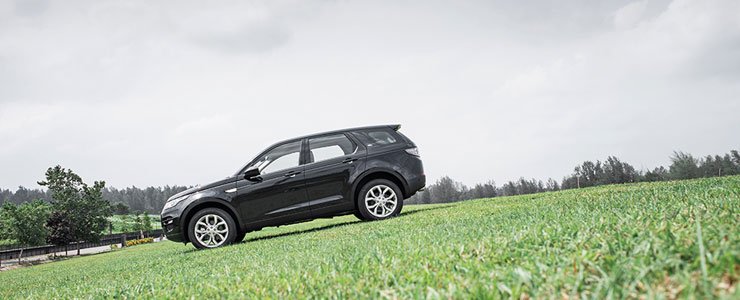 |
The Drive
The 2.0-litre turbocharged four-cylinder engine in the Discovery Sport is also taken from the Evoque. But with this car, Land Rover mated the engine to a new nine-speed ZF automatic transmission giving an average fuel consumption of about 12.2km/L, which is pretty impressive for an all-wheel drive (AWD) vehicle of its size.
While 237bhp and 340Nm of torque is not going to win you many traffic light drag races, it is more than enough to haul this compact Rover around.
There is, however, a small drawback with this new drivetrain. Engine lag and a slight hesitation during downshifts might prove as a challenge to drive the Disco Sport smoothly. This seems to be a characteristic amongst vehicles that use the same ZF-supplied transmission.
Although less sporty than the Evoque, the car still manages quick direction changes and steers with terrific precision. Steering feel is sturdy even at low speeds, but it also behaves in a very linear manner, making it easy to place the car on the road.
The 2.0-litre turbocharged four-cylinder engine in the Discovery Sport is also taken from the Evoque. But with this car, Land Rover mated the engine to a new nine-speed ZF automatic transmission giving an average fuel consumption of about 12.2km/L, which is pretty impressive for an all-wheel drive (AWD) vehicle of its size.
While 237bhp and 340Nm of torque is not going to win you many traffic light drag races, it is more than enough to haul this compact Rover around.
There is, however, a small drawback with this new drivetrain. Engine lag and a slight hesitation during downshifts might prove as a challenge to drive the Disco Sport smoothly. This seems to be a characteristic amongst vehicles that use the same ZF-supplied transmission.
Although less sporty than the Evoque, the car still manages quick direction changes and steers with terrific precision. Steering feel is sturdy even at low speeds, but it also behaves in a very linear manner, making it easy to place the car on the road.
One of the features that make the Disco Sport such a popular choice for off-roading is its four-mode Terrain Response system, which helps adapt to a variety of situations such as grass, gravel, snow, mud and sand. However, driving in a city like Singapore will hardly require any of that.
Conclusion
All in all, the Discovery Sport is a family-friendly, kid-hauling grocery-getting vehicle that offers a bit of fun when you feel like it.
What it also does is set you back by $240,000 for the base SE model and $260,000 for the top of the line HSE trim (as of 23rd July 2015) which may seem like a pinch, but really isn't too much to ask.
We say this taking into account that the 2.0-litre Audi Q5 and the 2.0-litre X line BMW X3 will cost you $254,100 (as of 31st July 2015) and $236,800 (as of 10th July 2015) respectively. Keeping in mind that the latter two cars don't come with seven seats, the Land Rover Discovery Sport is definitely a car worth considering.
Conclusion
All in all, the Discovery Sport is a family-friendly, kid-hauling grocery-getting vehicle that offers a bit of fun when you feel like it.
What it also does is set you back by $240,000 for the base SE model and $260,000 for the top of the line HSE trim (as of 23rd July 2015) which may seem like a pinch, but really isn't too much to ask.
We say this taking into account that the 2.0-litre Audi Q5 and the 2.0-litre X line BMW X3 will cost you $254,100 (as of 31st July 2015) and $236,800 (as of 10th July 2015) respectively. Keeping in mind that the latter two cars don't come with seven seats, the Land Rover Discovery Sport is definitely a car worth considering.
With the curtain call of Land Rover's introductory vehicle to the compact Sports Utility Vehicle (SUV) market segment, the Freelander, comes the British car manufacturer's all new and highly-anticipated Discovery Sport.
At a length of 4,590mm, the Discovery Sport offers seven seats in the dimensions of a five-seat SUV - something you won't find in the Audi Q5 or the BMW X3.
We had the privilege to get up close and personal with the Discovery Sport a couple of weeks ago at the ZF Global Press Event in Potsdam, Germany, where it was used as a test car to demonstrate the efficiency of the ZF nine-speed automatic transmission. Sure, the Discovery Sport was pretty decent around the track but how will Land Rover's new brainchild fare on our roads?
Exterior
Style may not be the first order of business when it comes to SUVs, but it plays a huge role in the decision making process. Replacing the Freelander with the Discovery Sport, Land Rover seems to be looking at a younger, and slightly less grizzled demographic with its bold and progressive architecture.
The anterior of the Discovery Sport is a composition of strong and dynamic lines, featuring the signature clamshell bonnet on top of a contradistinct two-bar, hexagonal meshed grille.
At a length of 4,590mm, the Discovery Sport offers seven seats in the dimensions of a five-seat SUV - something you won't find in the Audi Q5 or the BMW X3.
We had the privilege to get up close and personal with the Discovery Sport a couple of weeks ago at the ZF Global Press Event in Potsdam, Germany, where it was used as a test car to demonstrate the efficiency of the ZF nine-speed automatic transmission. Sure, the Discovery Sport was pretty decent around the track but how will Land Rover's new brainchild fare on our roads?
Exterior
Style may not be the first order of business when it comes to SUVs, but it plays a huge role in the decision making process. Replacing the Freelander with the Discovery Sport, Land Rover seems to be looking at a younger, and slightly less grizzled demographic with its bold and progressive architecture.
The anterior of the Discovery Sport is a composition of strong and dynamic lines, featuring the signature clamshell bonnet on top of a contradistinct two-bar, hexagonal meshed grille.
Illuminating the road is a pair of Xenon head lights with LED signature, a combination that creates an aggressive stance and commanding road presence.
One may recognise this front end design of the Discovery Sport from that of the Range Rover Evoque and although the new car is built alongside the Evoque at Land Rover's Halewood plant, it is almost entirely redesigned from the B-pillars back, giving the car a longer wheelbase to allow for more rear seat capacity. The car also sensibly ditches the Evoque's aggressively tapered roofline to cater for more headroom and visibility.
The decision to adopt the semblance of the Evoque whilst offering the practicality of an urban off-roader that is able to haul five adults and two children makes the Discovery Sport a class act - one perfectly capable of balancing style and space in a way that not many can.
One may recognise this front end design of the Discovery Sport from that of the Range Rover Evoque and although the new car is built alongside the Evoque at Land Rover's Halewood plant, it is almost entirely redesigned from the B-pillars back, giving the car a longer wheelbase to allow for more rear seat capacity. The car also sensibly ditches the Evoque's aggressively tapered roofline to cater for more headroom and visibility.
The decision to adopt the semblance of the Evoque whilst offering the practicality of an urban off-roader that is able to haul five adults and two children makes the Discovery Sport a class act - one perfectly capable of balancing style and space in a way that not many can.
Interior
Step inside the cabin and you will find that the Discovery Sport subscribes to Land Rover's belief that interior designs should be kept clean, simple and functional. In the driver's seat, both leg and headroom are aplenty and you get a clear elevated view of the road ahead thanks to Land Rover's raised Sports Command Driving Position.
Despite being similar in look and feel to the old infotainment system, the updated version in the Disco Sport is better in almost every way, especially in terms of speed and ease of user-friendliness.
The HSE trim we drove had full leather interior, a panoramic glass roof, sat-nav, keyless entry, optional heated rear seats and a rear view camera. Passengers won't have to worry about their phones' battery life, as the car comes equipped with four USB charging ports to ensure that everything stays charged on the go.
Step inside the cabin and you will find that the Discovery Sport subscribes to Land Rover's belief that interior designs should be kept clean, simple and functional. In the driver's seat, both leg and headroom are aplenty and you get a clear elevated view of the road ahead thanks to Land Rover's raised Sports Command Driving Position.
Despite being similar in look and feel to the old infotainment system, the updated version in the Disco Sport is better in almost every way, especially in terms of speed and ease of user-friendliness.
The HSE trim we drove had full leather interior, a panoramic glass roof, sat-nav, keyless entry, optional heated rear seats and a rear view camera. Passengers won't have to worry about their phones' battery life, as the car comes equipped with four USB charging ports to ensure that everything stays charged on the go.
With an extended wheelbase and some dexterous British engineering, Land Rover has managed to squeeze an optional third row seat into the Discovery Sport. Unique to its segment, Land Rover terms this as a 5+2 seating configuration.
As with all seven-seater SUVs, the optional third row folds out of the boot floor and is intended more for occasional usage because getting to them challenges you to squeeze through a small gap. While it's spacious enough for children, it may cause some discomfort for adults. However, when not necessary, keeping the third row folded flat ups the boot capacity to 981 litres.
Space is more generous in the second row. The seats have the ability to adjust the angle of the backrests, as well as a sliding function to increase or decrease legroom.
As with all seven-seater SUVs, the optional third row folds out of the boot floor and is intended more for occasional usage because getting to them challenges you to squeeze through a small gap. While it's spacious enough for children, it may cause some discomfort for adults. However, when not necessary, keeping the third row folded flat ups the boot capacity to 981 litres.
Space is more generous in the second row. The seats have the ability to adjust the angle of the backrests, as well as a sliding function to increase or decrease legroom.
The Drive
The 2.0-litre turbocharged four-cylinder engine in the Discovery Sport is also taken from the Evoque. But with this car, Land Rover mated the engine to a new nine-speed ZF automatic transmission giving an average fuel consumption of about 12.2km/L, which is pretty impressive for an all-wheel drive (AWD) vehicle of its size.
While 237bhp and 340Nm of torque is not going to win you many traffic light drag races, it is more than enough to haul this compact Rover around.
There is, however, a small drawback with this new drivetrain. Engine lag and a slight hesitation during downshifts might prove as a challenge to drive the Disco Sport smoothly. This seems to be a characteristic amongst vehicles that use the same ZF-supplied transmission.
Although less sporty than the Evoque, the car still manages quick direction changes and steers with terrific precision. Steering feel is sturdy even at low speeds, but it also behaves in a very linear manner, making it easy to place the car on the road.
One of the features that make the Disco Sport such a popular choice for off-roading is its four-mode Terrain Response system, which helps adapt to a variety of situations such as grass, gravel, snow, mud and sand. However, driving in a city like Singapore will hardly require any of that.
Conclusion
All in all, the Discovery Sport is a family-friendly, kid-hauling grocery-getting vehicle that offers a bit of fun when you feel like it.
What it also does is set you back by $240,000 for the base SE model and $260,000 for the top of the line HSE trim (as of 23rd July 2015) which may seem like a pinch, but really isn't too much to ask.
We say this taking into account that the 2.0-litre Audi Q5 and the 2.0-litre X line BMW X3 will cost you $254,100 (as of 31st July 2015) and $236,800 (as of 10th July 2015) respectively. Keeping in mind that the latter two cars don't come with seven seats, the Land Rover Discovery Sport is definitely a car worth considering.
Conclusion
All in all, the Discovery Sport is a family-friendly, kid-hauling grocery-getting vehicle that offers a bit of fun when you feel like it.
What it also does is set you back by $240,000 for the base SE model and $260,000 for the top of the line HSE trim (as of 23rd July 2015) which may seem like a pinch, but really isn't too much to ask.
We say this taking into account that the 2.0-litre Audi Q5 and the 2.0-litre X line BMW X3 will cost you $254,100 (as of 31st July 2015) and $236,800 (as of 10th July 2015) respectively. Keeping in mind that the latter two cars don't come with seven seats, the Land Rover Discovery Sport is definitely a car worth considering.
Also read our comparison article on:
Infiniti QX70 3.7 vs Lvs Rover Discovery Sport 2.0 vs Lexus RX200tCar Information
Land Rover Discovery Sport 2.0 HSE 7-Seater (A)
CAT B|Petrol|12km/L
Horsepower
177kW (237 bhp)
Torque
340 Nm
Acceleration
8.2sec (0-100km /hr)
This model is no longer being sold by local distributor
All Used Land Rover Discovery SportThank You For Your Subscription.
























